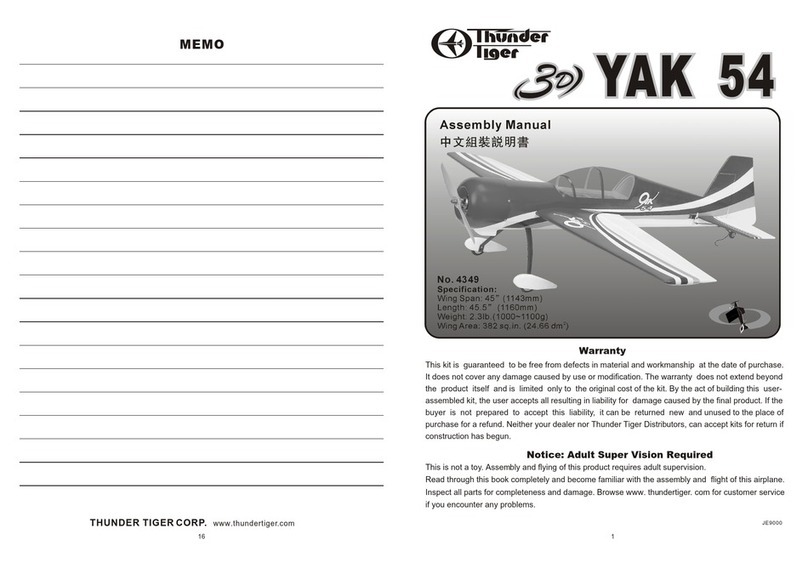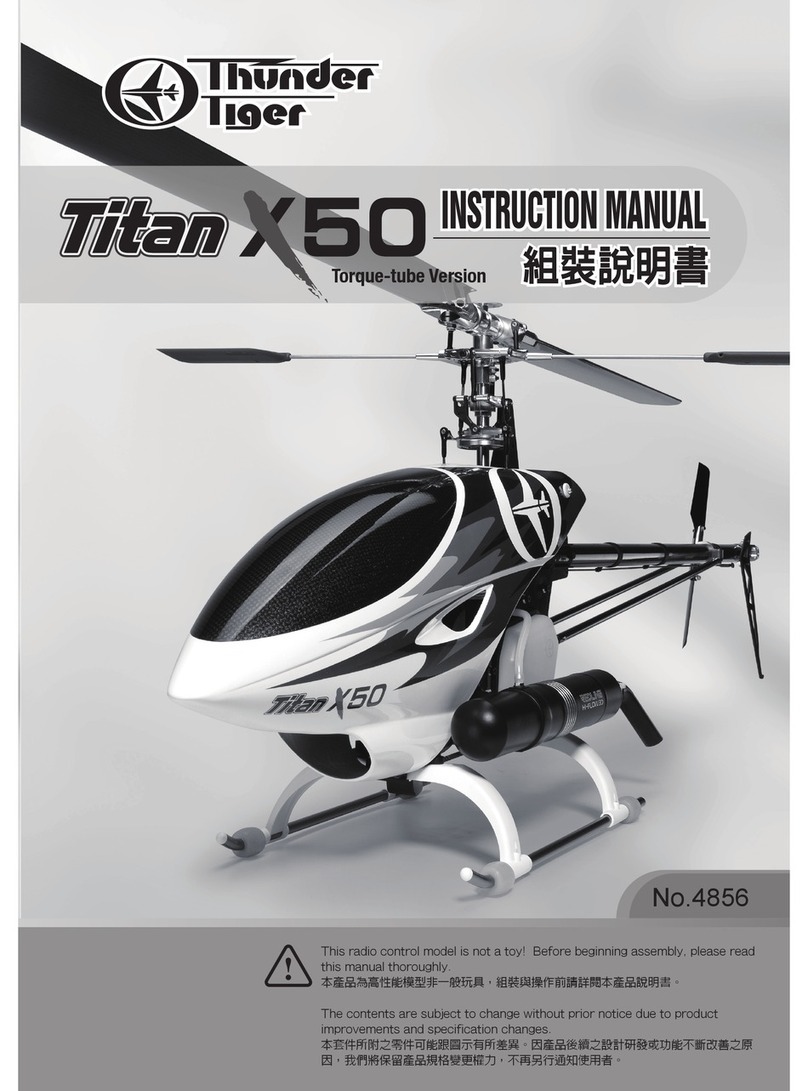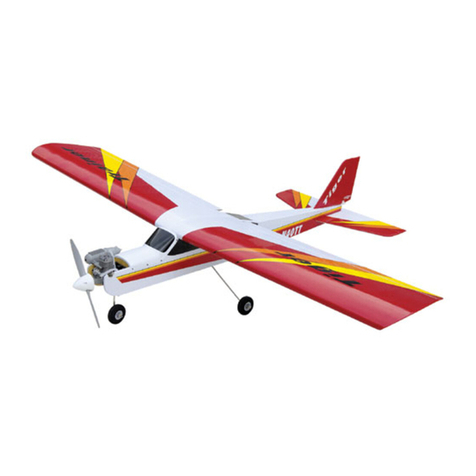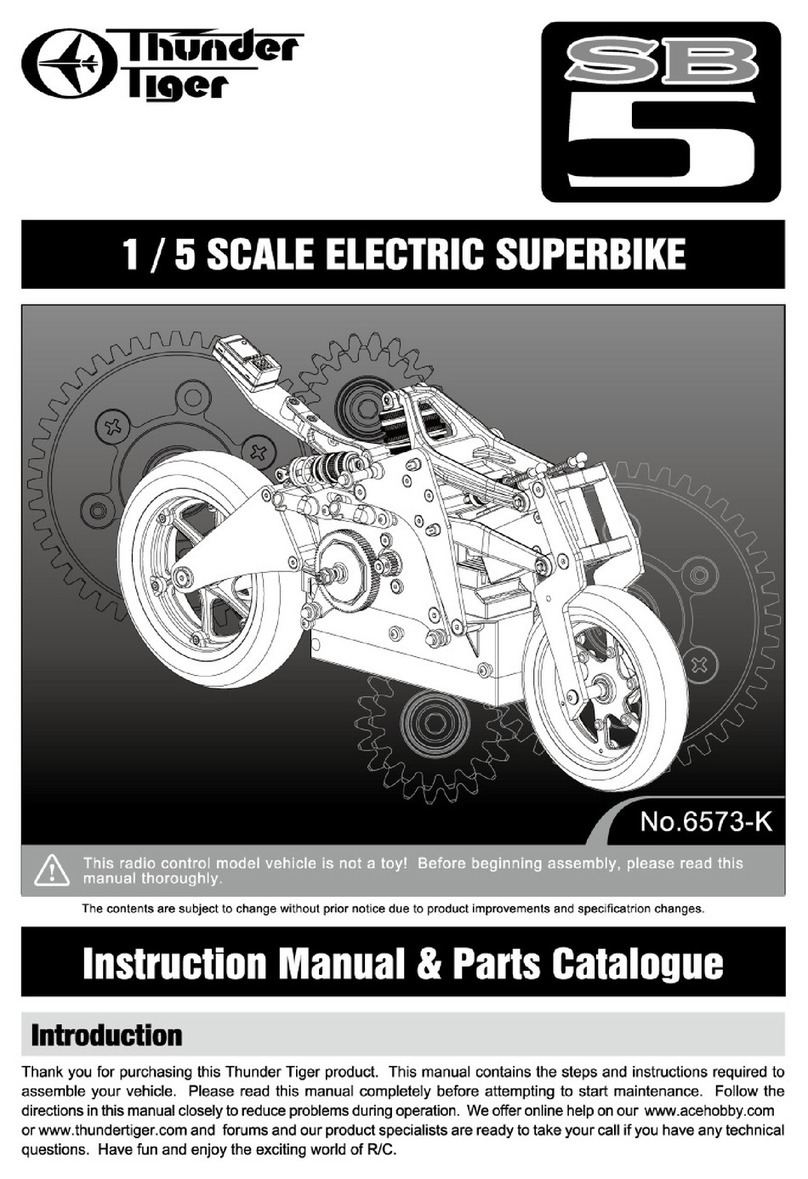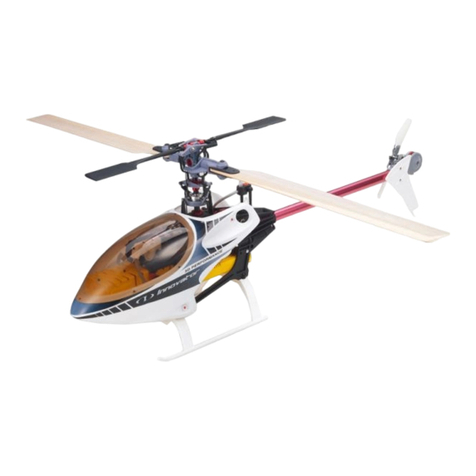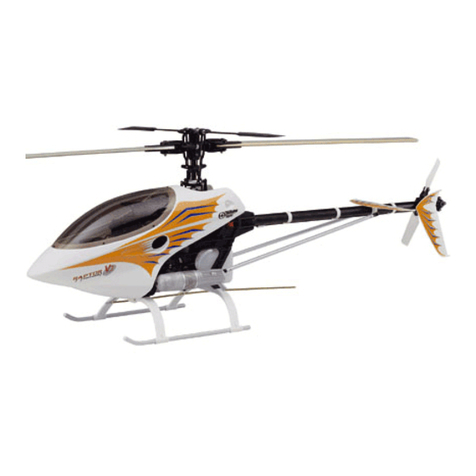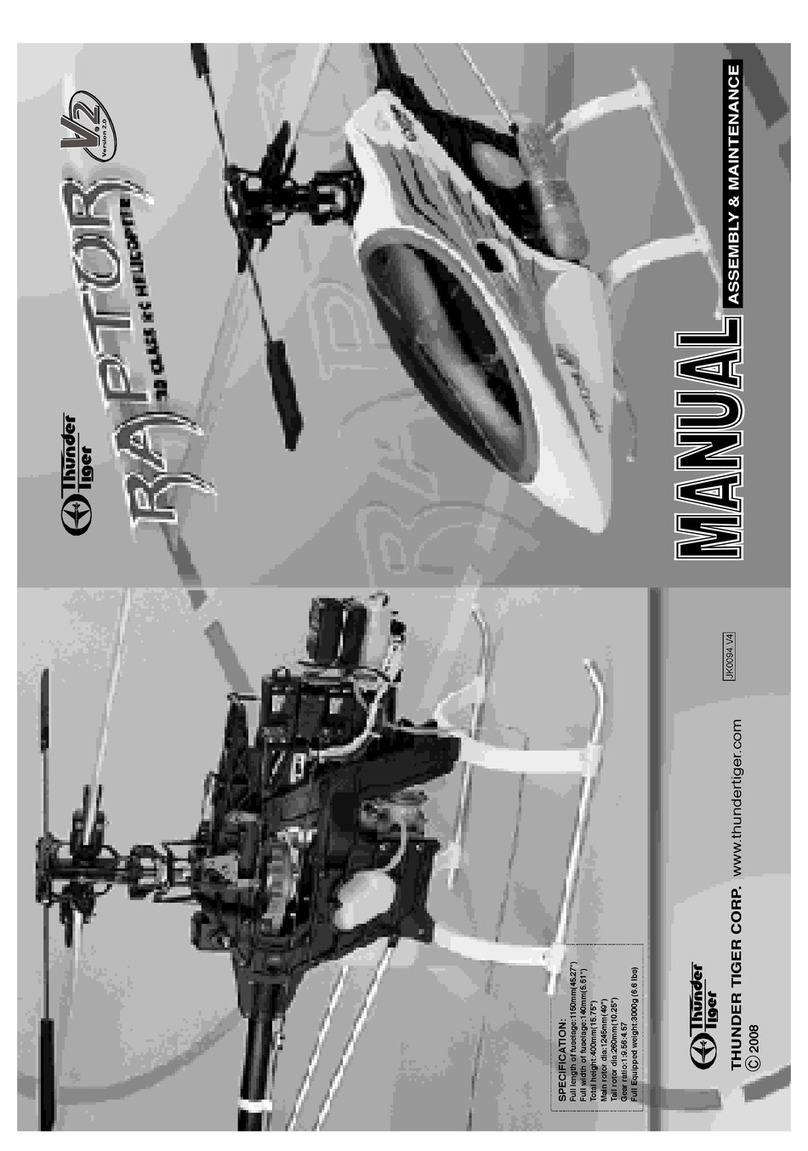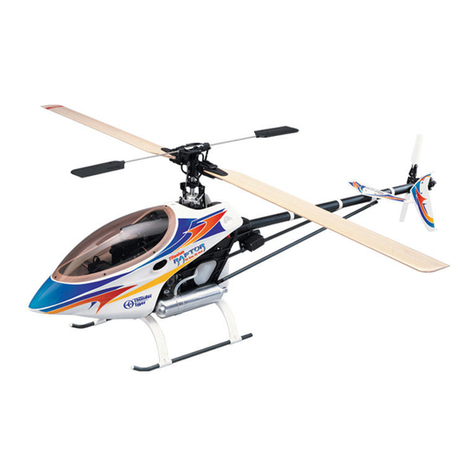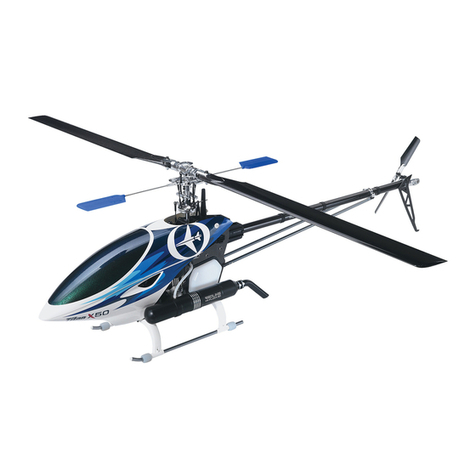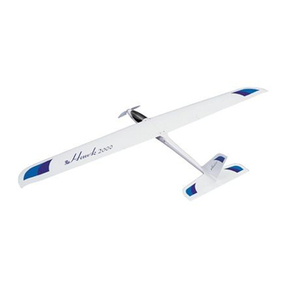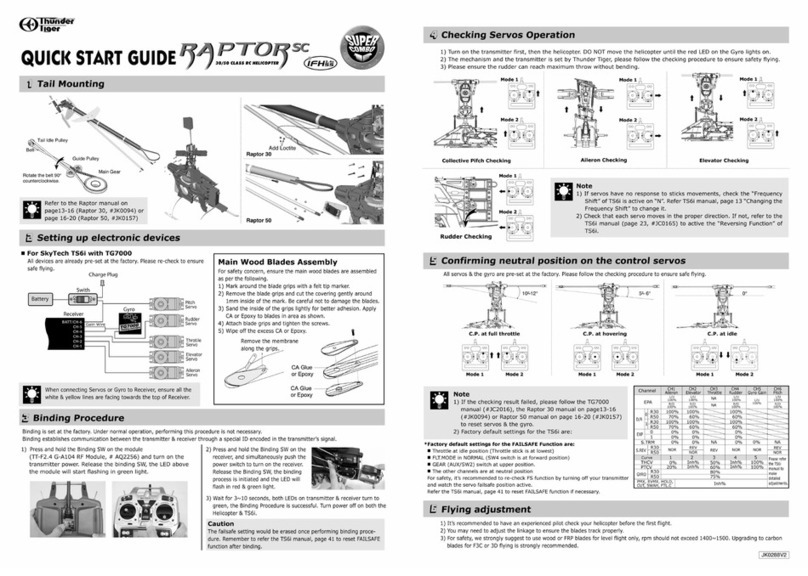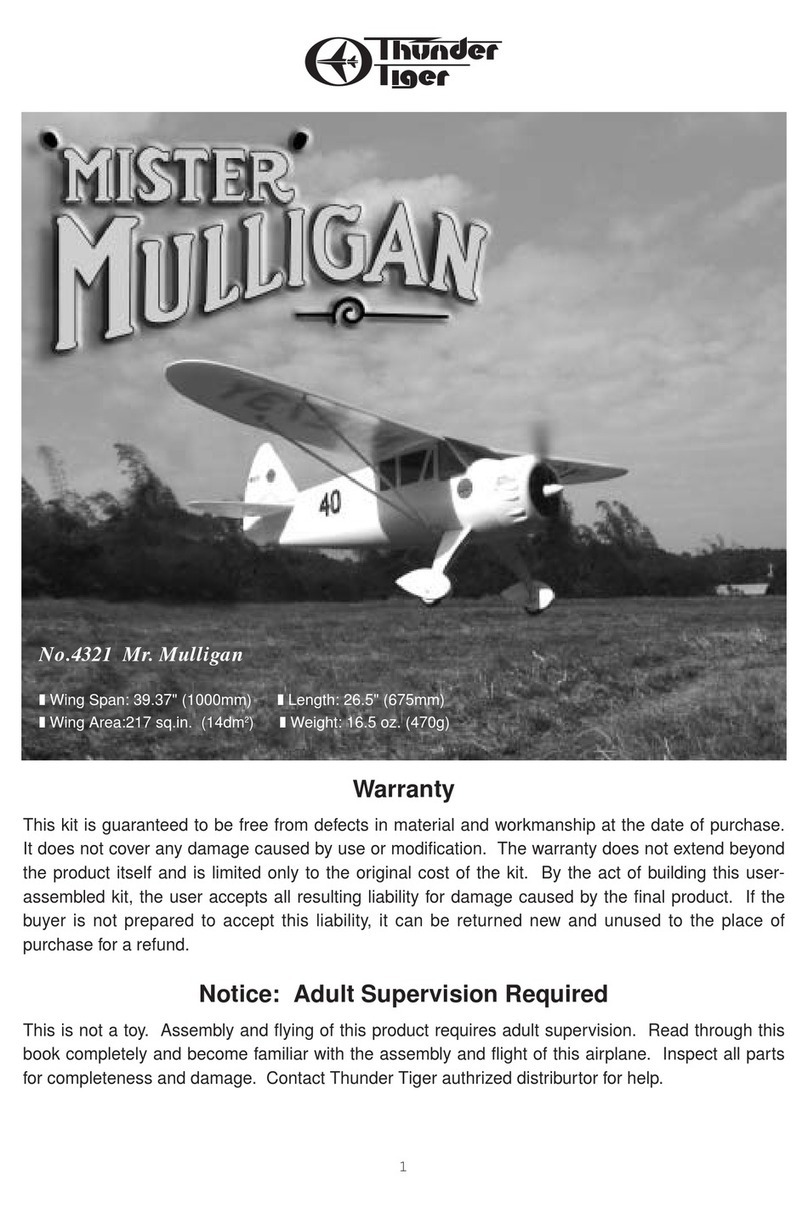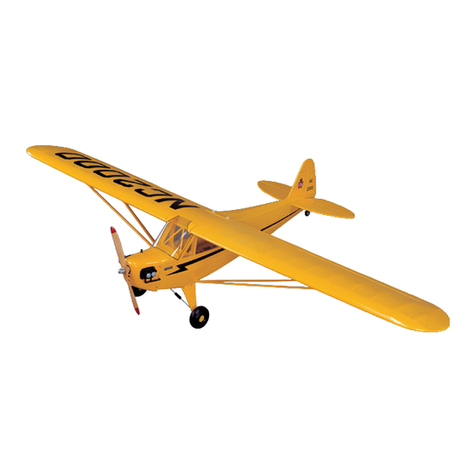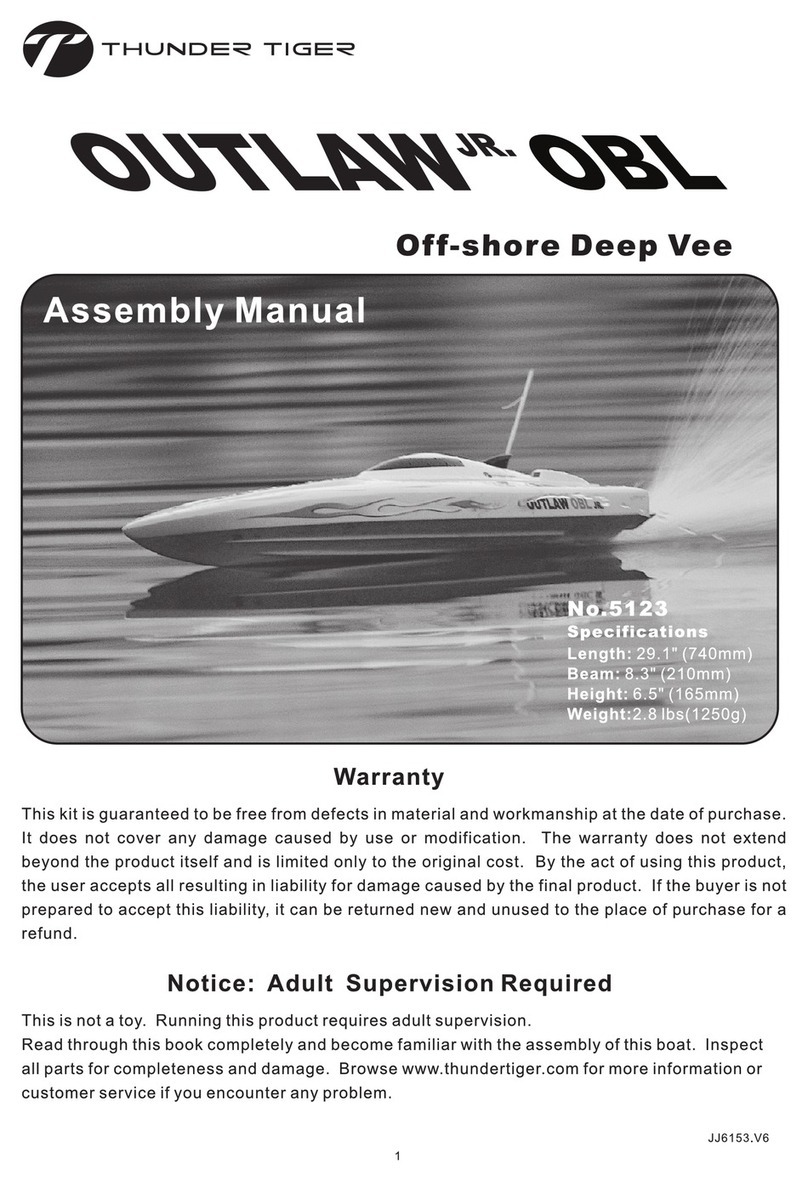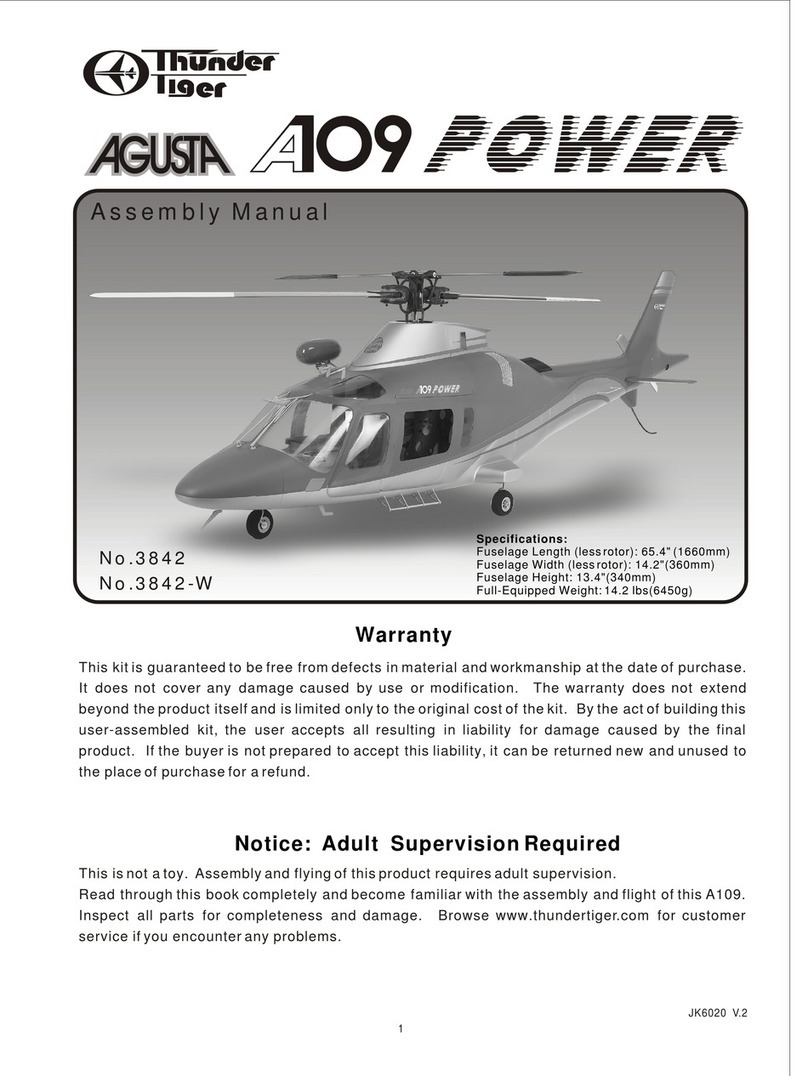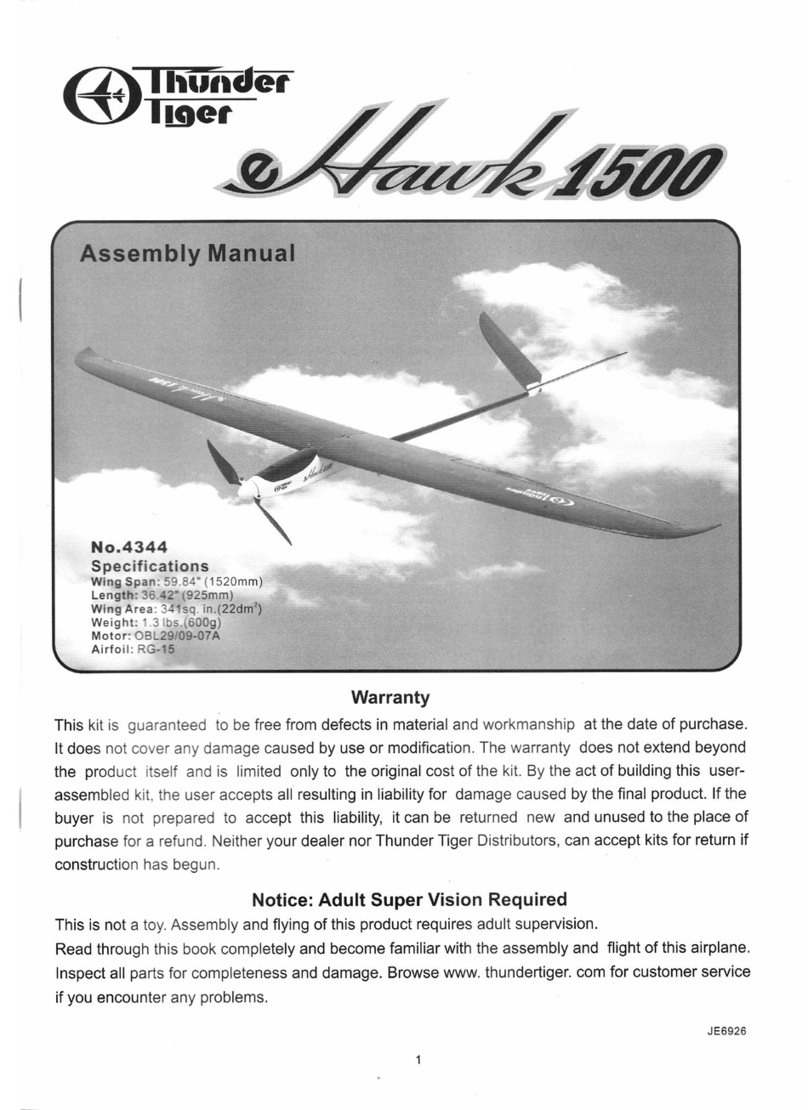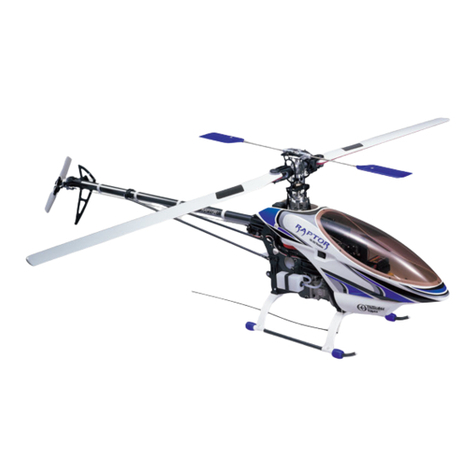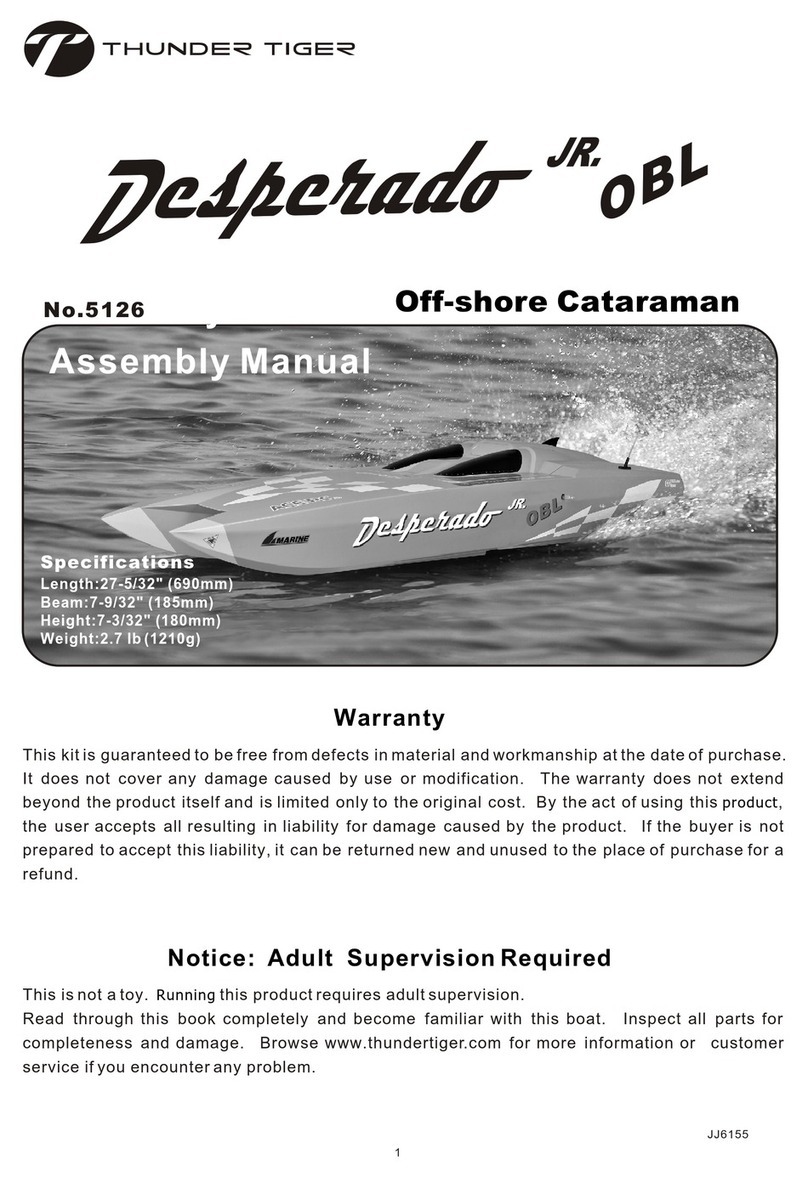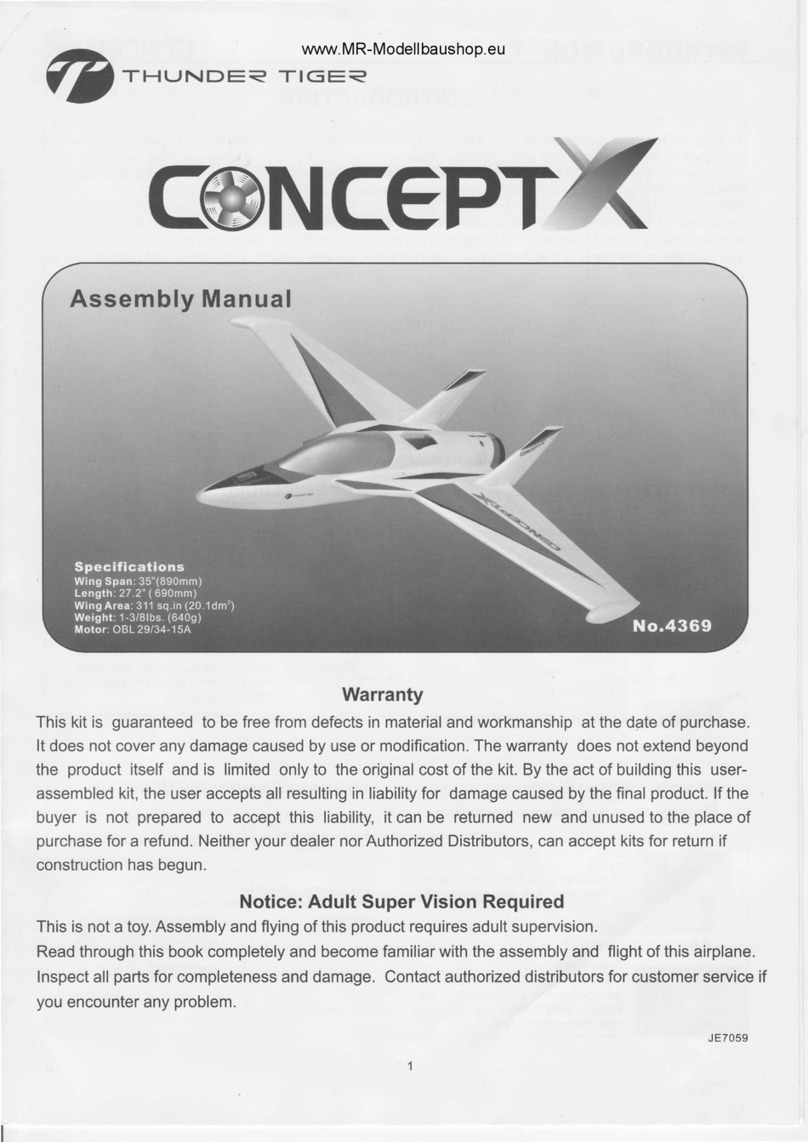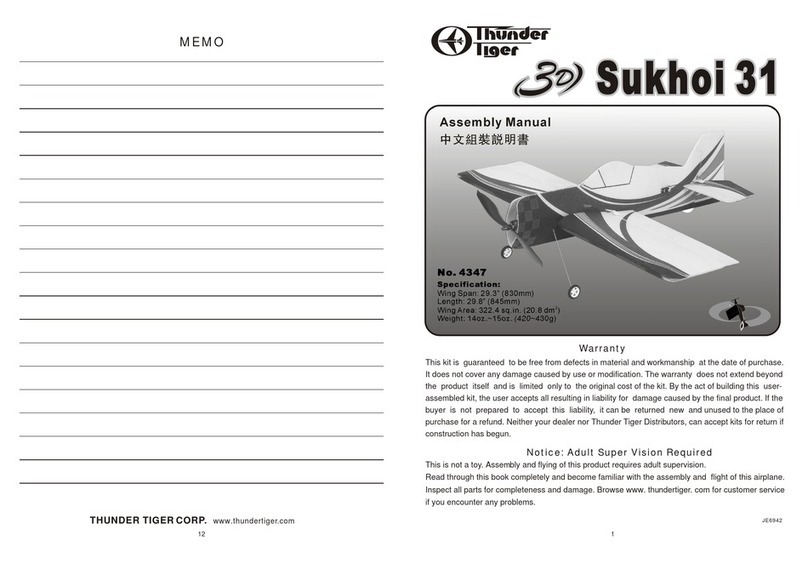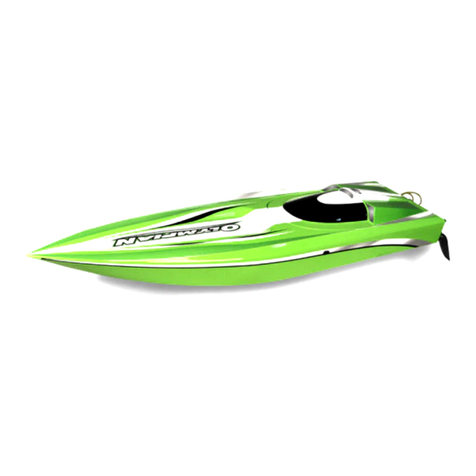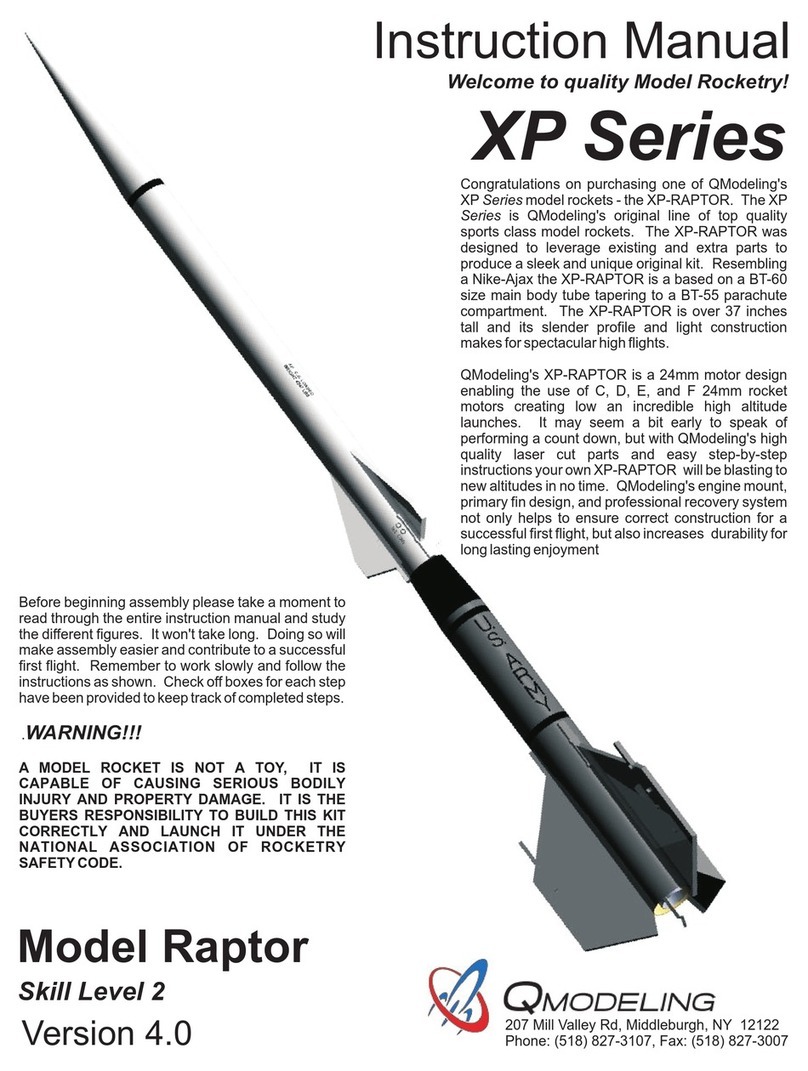15
SAFETY PRECAUTIONS
3.Clean theplane with papertowels and a light-duty
spray cleanser.Keeping your planeclean will make it last
longer and keep it looking nice.
4.Put a few drops of after-run or light oil in the carburetor
and turn the prop over a few times (without the glow plug
ignited) to distribute the oil throughout the engine.
5.Inspect the prop and replace it ifany chips or cracks
are found.
6.Inspect the entire plane for covering tears, new dings
and dents, loose screws and connect connectors and
any other wear and tear.
7.Use a voltmeter to check the receiver battery voltage.
If it is low, you now know not to fly so long next time. If it
is still high,you should beable to fly a little longer next
session.
1.Wear safety glasses when starting and running all
model engines.
2.Model engine fuel is very flammable and the flame is
very dangerous because it is almost invisible! Do not
smoke or allow sparks, high heat or other flames near
the fuel.
3.Do not run model engines inside garage or other
closed room as they give off large amounts of deadly
carbon monoxide gas.
4.Do not run model engines around gravel, sand or other
loose debris. These materials will be ingested through
the carburetor and can also be kicked up by the prop.
5.Always stay behind the propeller when the engine is
9.If you hear any unusual noises while your plane is
flying, land at once and determine the problem before
returning to the air. Control surface flutter, which often
emits a low-pitched Buzz, can quickly destroy an
airplane and should not be ignored. Flutter is usually
caused by sloppy control surfaces and is generally
relatively easy to cure.
running. Make all engine adjustments from behind the
engine. Under no circumstances should you allow your
face or body near the plane on rotation of the propeller
when the engine is running.
6.Do not allow loose clothing or other loose objects close
to the prop.
7.To stop an engine, cut off the fuel or air supply to the
engine. Do not throw rags or other objects into the prop to
stop the engine.
8.Do not touch the engine or muffler duringor right after it
has been running-It gets very hot!
SAFETY PRECAUTIONS
14
PRE-FLIGHT CHECKS
Learning to fly a radio control aircraft can be very exiting,
but it is important that you thoroughly understand the
basics of flight and controls before you attempt yourfirst
flights. Therefore, we highly recommend that you seek
the expertise of an experienced instructor pilot for the
first few flights. He (or she ) can get you in the air much
more smoothly than trying everything yourself for the
first time.
FLYING
GETTING ORIENTED
We recommend that you find a large smooth and clear
surface to practice taxing your airplane around inbefore
you try to take off. To taxi, you only need to use the
rudder stick. At the slow speeds encountered during
taxing, the elevator and ailerons will not be effective.
The first and most important thing to remember when
controlling model aircraft is: the model controls are set
up to operate as if you were sitting in the cockpit of the
model. This means that when you pull back (down) on
the elevator stick the nose of the plane will go up.
Moving the rudder stick to the right will “yaw” the plane
to the right and moving the aileron stick to the right will
“roll” the plane to the right. Pretty simple right? Well, not
quite. Since you are really standing on the ground and
not sitting in the plane, this is how the controls work
when you are facing the same direction the plane is
flying. The problem is that when the plane is flying
towards you, the rudder and aileron controls seem
reversed to the inexperienced pilot. This is the reason
we recommend that you practice taxing around in a large
open area to try and get used to the control reversal.
During your first few flights, try to face the direction that
the plane is flying and looking over your shoulder as
needed. This makes it a little easier to pretend that your
sitting in thecockpit.
FIRST FLIGHT
When you are comfortable with the controls, you should
be ready for your first flight. Go over the Pre-Flight
Check List one more time for good measure and taxi out
the runway (hopefully with an experienced pilot by your
side). Point the model directly into the wind and
gradually increase the throttle to full throttle. As the
model starts rolling forward it may try to turn to the left
due to the engine torque. Apply enough right rudder to
keep the plane rolling relatively straight into the wind. If
you built the model with right thrust, this tendency may
not be noticeable. As the plane picks up speed, the right
rudder input can be reduced.
Once the plane reaches flying speed, it will probably try
to fly by itself. If the grass seems to be impeding take off ,
a very slight amount of “up” elevator can be applied, but
TIGER STICK 40
If you get disoriented or the plane gets out of control,
simply take your hands off all the controls and allow the
plane to stabilize. Clear your head and try to picture
yourself sitting in the cockpit. Then input the required
control movements to get the plane back on the correct
flight path. If you run out of time or flying space and
realize the plane is going to hit something (ground, tree,
etc), pull the throttle back to idle and pull the elevator
stick back about half way. This will reduce the speed of
the plane and minimize the damage sustained.
When you are ready to land,do a couplerof slow fly-bys
at a safe altitude to get familiar with the plane's slow-
flying characteristics. An important factor to remember
here is that you should regulate you altitude with the
throttle not the elevator as you might expect. Practice
raising the nose of plane slightly with a touch of “up”
elevator and then using the throttle to regulate the
plane’s altitude. When you are ready to land, fly
downwind past the runway. When the plane is a
hundred yards or so downwind, reduce the throttle
almost an idle and turn 90 degrees towards the runway.
Fly straight for a second or two until the plane is almost
even with the runway. Turn 90 degrees again and fly
directly toward the runway using the throttle to govern
how quickly the plane is descending. Keep the nose of
plane up slightly with the elevatorand allow the plane to
fly gently onto the runway. Do not try to stretch the glide
path without increasing the throttle or the plane may
stall.
POST-FLIGHT CHECK LIST
5. Check the level of charge in both the transmitter and
receiver batteries before flying.
6. Range check the radio both with and without the
engine running! Followthe radio manufacturer's
instructions for this.
it is very important that you do not apply too much up
elevator too early or the plane will stall and roll over into
the ground.
As the plane becomes airborne, reduce the “up” elevator
and allow the plane to pick up flying speed while gently
gaining altitude. Once a safe flying speed and altitude
has been obtained, feel free to turn the airplane back
toward the flying field. Make all control inputs smoothly
and gradually so you can see the effect they have on the
plane. A small amount of “up” elevator will need to be
applied to keep plane level during turns. You should be
able to reduce the throttle to about ½ throttle for normal
cruising flight which will reduce the flying speed and give
you more time to think about what is going on. You will
find that once airborne, you can fly the plane with only the
aileron and elevator sticks. This is perfectly fine and will
make it much easier for you to learn.
If the plane has a tendency to turn, roll, climb, or dive, you
can adjust the transmitter trims to correct this. On your
first flights, it might be a good idea to have an
experienced pilot make the adjustments for you while you
fly the plane.
1.Be sure that both the transmitter and receiver switches
are turned off.
2.Drain all excess fuel from the tank. Fuel left in the tank
for extended periods can “gunk up” the tank, fittings and
carburetor.
